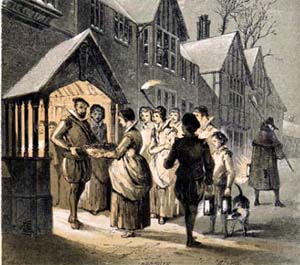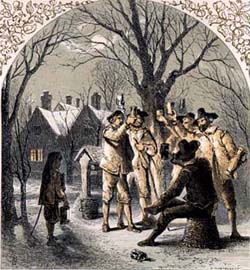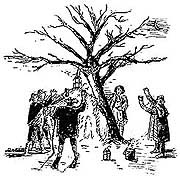Here We Go A-Wassailing
by Lisa Agnew
 There are three forms of Christmas/New Year
celebration involving wassail, a beverage originally made of
mulled ale, curdled cream, roasted apples, nuts, eggs and spices.
In modern times the concoction has been replaced by eggnog or
spiced cider, but the legend of its inception goes right back to
Saxon times and is spelt out in Geoffrey of Monmouth's History
of the Kings of Britain and involves Rowena, daughter of
Hengist, a Saxon mercenary, who presents the future King
Vortigern with a bowl of mulled wine and the cheer "Waes Hael!",
meaning good health. Vortigern, of course, falls in love with
the beautiful Saxon maiden and marries her. Traditionally this
drink and its more modern variant, Lamb's Wool, is served on New
Year's Eve and Twelfth Night. Lambs Wool is heated cider spiced
with sugar, nutmeg and ginger. Roast apples float on the surface
and when the soft apple pulp bursts into the vat, it gives the
drink a frothy or woolly look. There are three forms of Christmas/New Year
celebration involving wassail, a beverage originally made of
mulled ale, curdled cream, roasted apples, nuts, eggs and spices.
In modern times the concoction has been replaced by eggnog or
spiced cider, but the legend of its inception goes right back to
Saxon times and is spelt out in Geoffrey of Monmouth's History
of the Kings of Britain and involves Rowena, daughter of
Hengist, a Saxon mercenary, who presents the future King
Vortigern with a bowl of mulled wine and the cheer "Waes Hael!",
meaning good health. Vortigern, of course, falls in love with
the beautiful Saxon maiden and marries her. Traditionally this
drink and its more modern variant, Lamb's Wool, is served on New
Year's Eve and Twelfth Night. Lambs Wool is heated cider spiced
with sugar, nutmeg and ginger. Roast apples float on the surface
and when the soft apple pulp bursts into the vat, it gives the
drink a frothy or woolly look.
The first Wassail celebration involves Christmas revellers taking
a Wassail bowl, usually a large wooden vessel (although ornate
examples have been crafted of silver or pewter) from house to
house to distribute good cheer. If one was in the regent's
court, the bowl was passed from hall to hall as a form of loving
cup. However, the most ancient form of the Wassail celebration
involves the blessing of trees and bees, so important to
pollination, to ensure a healthy crop for the coming year. One of
the songs associated with this practice declares,
Here's to thee, old apple tree,
Whence thou may'st bud, and thou may'st blow,
And whence thou may'st bear apples enow,
Hats full! Caps full!
Bushel -- bushel -- sacks full!
And my pockets full too! Huzza!
 The earliest known practice was to pour a sanctified
liquid onto the dormant crops and orchards after the harvest,
blessing the ground for the coming of spring and warding off
evil. This evolved into the Wassailing of the Apples Trees
celebration. The village of Carhampton in Somerset still
celebrates the Wassailing of the Apple Trees on Old Twelfth Night
(January 17). Other regions hold similar observances on
traditional Twelfth Night (January 5). Other trees may be
wassailed, yet most usually it is the sturdiest apple tree in the
orchard which is so honoured. The apple has long enjoyed a
special place in the diet of the English. The fruit is said to
be effective against melancholy and to 'smele to an old swete
apple' helps one recover his strength. By Shakespeare's time,
apples were a favourite dessert, easily cooked to a consistency
suitable for young and old alike. The earliest known practice was to pour a sanctified
liquid onto the dormant crops and orchards after the harvest,
blessing the ground for the coming of spring and warding off
evil. This evolved into the Wassailing of the Apples Trees
celebration. The village of Carhampton in Somerset still
celebrates the Wassailing of the Apple Trees on Old Twelfth Night
(January 17). Other regions hold similar observances on
traditional Twelfth Night (January 5). Other trees may be
wassailed, yet most usually it is the sturdiest apple tree in the
orchard which is so honoured. The apple has long enjoyed a
special place in the diet of the English. The fruit is said to
be effective against melancholy and to 'smele to an old swete
apple' helps one recover his strength. By Shakespeare's time,
apples were a favourite dessert, easily cooked to a consistency
suitable for young and old alike.
The blowing of horns heralds the Wassailing of the Apple Trees
celebration, as a beverage, usually cider, is poured on the roots
of the finest tree and a wassail cake placed in the branches as
an offering to the tree spirits and elementals who ensure
fruitful harvest. Then the beating of kettles and firing of guns
loaded with powder are used to drive away the witches and ghosts
believed to reside in the crown of the apple tree. This is
followed by a wassailing song sung to the tree (or the hive in
the tree, in the case of bees!) as in --
Wassail, wassail all round the town;
The zider-cup's white and the zider's brown;
Our zider is made vrom good apple trees,
And now my vine vellows we'll drink if you please.
 It was also believed,
especially in the West Country, that the spirits of the trees
were incarnated in robins and other small birds. Young lads
representing these birds climbed the apple trees and cried
'Tit-tit, I want more to eat.' A piece of cake, cheese or bread
was either handed up to him or dipped in cider and placed in the
forks of the tree branches 'for the robins'. It was also believed,
especially in the West Country, that the spirits of the trees
were incarnated in robins and other small birds. Young lads
representing these birds climbed the apple trees and cried
'Tit-tit, I want more to eat.' A piece of cake, cheese or bread
was either handed up to him or dipped in cider and placed in the
forks of the tree branches 'for the robins'.
When the farmers return to their homes, tradition dictates that
they be denied entrance to their hearth until they guess the name
of the roast being prepared within, a game which usually does not
take that long! Then the party begins anew.
As this was the end of the traditional Christmas season, it was
also seen as a time for one last revelry, with games and plays,
often overseen by the Lord of Misrule, a peasant or similar
unfortunate chosen by the gentry to be Lord for the Day.
Shakespeare's play Twelfth Night was more than likely
written for a Twelfth Night celebration at Elizabeth I's court in
1601. Wassail and Twelfth Night were part of the entire Yule
celebration, a period of mid-winter festivity dating from well
before the time of Christ. Over the centuries other elements
have been added to this pagan celebration, so that aspects of
Christian mythology, such as the mummers' plays starring King
Herod and St George, are enacted side by side with more ancient
symbology. Thirteen fires are lit about the area of the
celebrations, twelve small and one extra large. Many
interpretations have been given to these fires -- the twelve
apostles and Christ, twelve months in the year overseen by the
sun etc. -- although, again, the true reason is probably so old
that it has long been forgotten.
The Oxhorn Dance is another prehistoric remnant, consisting of
six dancers bedecked in oxen costume. They circle around the
foot of the tree that was honoured in the Wassailing ceremony,
their stamping a signal to awaken the animal and earth spirits
for spring time. The best of these performers is honoured by
having an Oxhorn Cake, similar to the wassail cake, placed on his
ox horn. He must then dance around and try to dislodge the cake
as the watching revellers eat their own versions of this delicacy
and try to guess whether the Oxhorn Cake will fall before or
behind the ox performer.
The obvious pagan undertones of these celebrations did not augur
well with the Christian church, especially the Puritan faction.
In Scotland, John Knox put an end to Christmas in 1562. In
England the observance of Christmas was forbidden by an Act of
Parliament in 1644, which declared Christmas "an extreme
forgetfulness of Christ by giving liberty to carnal and sensual
delights." The House of Commons sat on Christmas Day and sheriffs
were sent out into the countryside to make sure that merchants
opened for business on the day. This led to a situation of
stand-off between Pro-and anti-Christmas factions and riots
ensued. Upon the restoration of Charles II to the throne,
Christmas celebrations were once again permitted.
Article © 2005 Lisa Agnew
|
